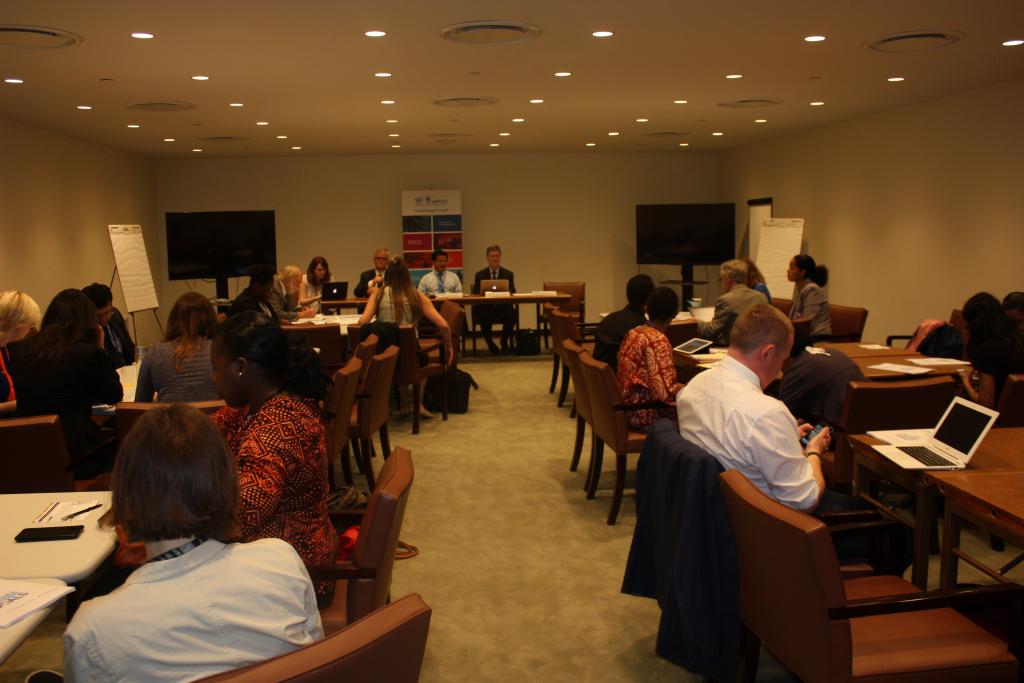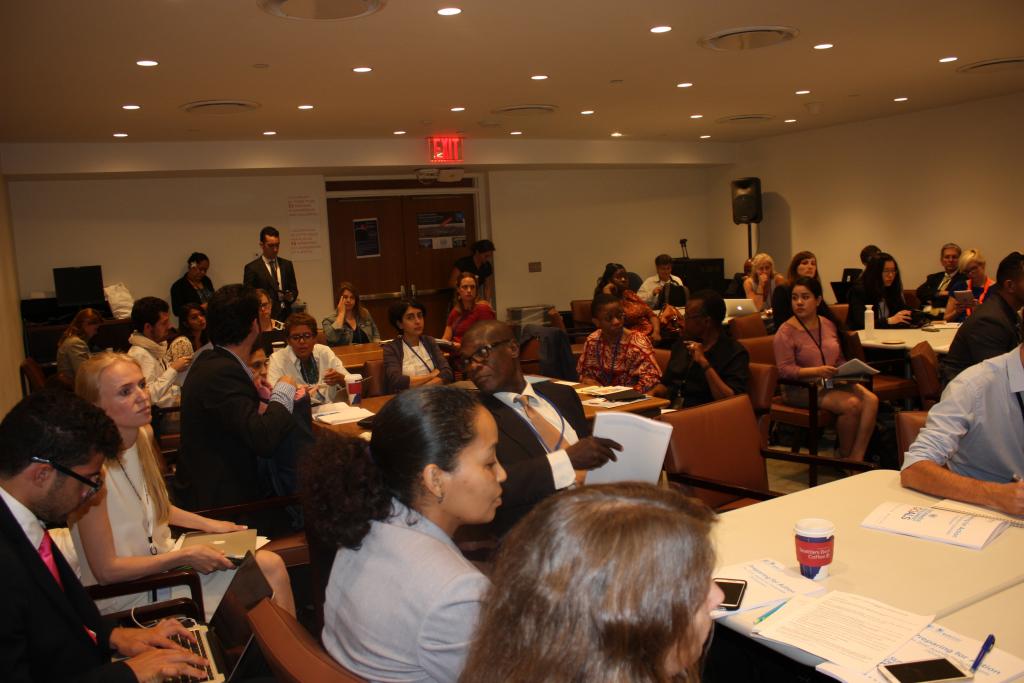UNITAR Delivers Harmonizing Global, Regional, and National Commitments to Implement the SDGs Seminar to the New York Diplomatic Community
18 July 2016, New York, USA - The United Nations Institute for Training and Research's (UNITAR) New York Office hosted the seminar “Harmonizing Global, Regional, and  National Commitments to Implement the SDGs” on 14 July 2016 at United Nations (UN) Headquarters during the High-Level Political Forum. The seminar was attended by approximately 50 delegates from Permanent Missions to the UN and members of civil society. Mr. Nikhil Seth, Executive Director of UNITAR, opened the session by speaking to the issue of multiple agendas and presenting the question, “How do we align all of these agendas and goals?”
National Commitments to Implement the SDGs” on 14 July 2016 at United Nations (UN) Headquarters during the High-Level Political Forum. The seminar was attended by approximately 50 delegates from Permanent Missions to the UN and members of civil society. Mr. Nikhil Seth, Executive Director of UNITAR, opened the session by speaking to the issue of multiple agendas and presenting the question, “How do we align all of these agendas and goals?”
Mr. Jeffery Sachs, the Director of Earth Institute and Quetelet Professor of Sustainable Development at Columbia University, presented first. He addressed the two major ways in which the Global economy would need to change to support and adapt to the Sustainable Development Goals (SDGs). Firstly, the global economy would need to become environmentally sustainable and friendly. Secondly, it would need to become socially fair. Mr. Sachs then proceeded to lay out the strategy that the SDG designers hoped the global community would pursue. Namely, that all nations would recognize that they need to change to achieve the SDGs by 2030. He illustrated that this would play out differently for each nation, explaining that some nations can achieve these goals in less than a few years because they have the budget to do so, all that must change for them is the ideological, conceptual, or organizational issuers preventing them from doing so. However, there are some  nations that will not achieve the SDGs without external help because they simply cannot invest in these goals while also supporting their economy and sustaining themselves. Mr. Sachs emphasized that the solution to this imbalance is for the less financially able states to create a plan to meet the SDGs, fully complete with a budget, timetable, and implementation plan. This plan would grant the international community a fully researched quantitative breakdown of needs with results to measure investment returns by. From this comes the ability to petition the international community to create a global fund for the achievement of the SDGs. As a follow up to several questions, Mr. Sachs addressed civil society’s role in pursuance of the SDGs. Specifically he encouraged civil institutions to push their governments for a plan, and to help create that plan if able. Mr. Sachs spoke against choosing only certain goals as they are all one goal in 17 different parts and the whole project can fail if nations only choose a few goals and leave the others behind.
nations that will not achieve the SDGs without external help because they simply cannot invest in these goals while also supporting their economy and sustaining themselves. Mr. Sachs emphasized that the solution to this imbalance is for the less financially able states to create a plan to meet the SDGs, fully complete with a budget, timetable, and implementation plan. This plan would grant the international community a fully researched quantitative breakdown of needs with results to measure investment returns by. From this comes the ability to petition the international community to create a global fund for the achievement of the SDGs. As a follow up to several questions, Mr. Sachs addressed civil society’s role in pursuance of the SDGs. Specifically he encouraged civil institutions to push their governments for a plan, and to help create that plan if able. Mr. Sachs spoke against choosing only certain goals as they are all one goal in 17 different parts and the whole project can fail if nations only choose a few goals and leave the others behind.
Mr. Haldoor Thorgeirsson, the Director for Strategy at United Nations Framework Convention on Climate Change, then presented on the importance of the first necessary global economic change, becoming environmentally sustainable. Mr Thorgeirsson recast the issue of investing in an environmentally sustainable future as one of re-direction, not of new creation. He further stated that we are in a conceptual struggle between long term thinking and short term urgency. In a brief story about the Paris Agreement, Mr. Thorgeirsson remarked on the unusual way in which contributions were made to the agreement, namely before the agreement, not after as is typically the case. This is because some countries can visibly see the effects of climate change and pollution in their daily lives and seek to control their own destinies and change the state of life in their communities. Home-grown support for environmental sustainability is essential in bringing about change. Mr Thorgeirsson unified the Paris agreement with the SDGs by explaining that the Paris agreement is a tool that serves to set an upper limit of allowable warming, build resilience into sustainability initiatives and align financial clout to allow the rational movement of the market toward environmentally sustainable practices.
importance of the first necessary global economic change, becoming environmentally sustainable. Mr Thorgeirsson recast the issue of investing in an environmentally sustainable future as one of re-direction, not of new creation. He further stated that we are in a conceptual struggle between long term thinking and short term urgency. In a brief story about the Paris Agreement, Mr. Thorgeirsson remarked on the unusual way in which contributions were made to the agreement, namely before the agreement, not after as is typically the case. This is because some countries can visibly see the effects of climate change and pollution in their daily lives and seek to control their own destinies and change the state of life in their communities. Home-grown support for environmental sustainability is essential in bringing about change. Mr Thorgeirsson unified the Paris agreement with the SDGs by explaining that the Paris agreement is a tool that serves to set an upper limit of allowable warming, build resilience into sustainability initiatives and align financial clout to allow the rational movement of the market toward environmentally sustainable practices.
Ambassador Kamau, Ambassador and Permanent Representative of the Republic of Kenya to the United Nations, spoke on the needed changes within the United Nations to accomplish the SDGs. His thesis was that we are striving for a change of mind-set at every level of government around the world, including at the UN. Speaking in support of a necessary coherent approach to the SDGs, his Excellency gave the example of poverty as a globally distracting issue that absorbs massive amounts of political discussion and prevents action on other actionable issues. Next he addressed the potential of properly harnessed technology, political leadership, and innovative practices can help transform  otherwise stagnated or stunted economies, thereby better enabling them to invest toward and achieve the SDGs. He added that nations constantly falling into sectarian violence and social unrest will never achieve the SDGs due to the lack of legislative coherence such countries experience. In response to a question about the nature of some of the SDGs Ambassador Kamau put them into three categories and stressed that each need to be achieved in concert with each other to avoid worse social ills and natural disasters in coming years. The drags are the goals that show we have achieved the SDGs in general, accelerators are the ones that will help us achieve the others faster, and the time-bombs are those that will spell disaster for humans across national boundary lines if we do not achieve them.
otherwise stagnated or stunted economies, thereby better enabling them to invest toward and achieve the SDGs. He added that nations constantly falling into sectarian violence and social unrest will never achieve the SDGs due to the lack of legislative coherence such countries experience. In response to a question about the nature of some of the SDGs Ambassador Kamau put them into three categories and stressed that each need to be achieved in concert with each other to avoid worse social ills and natural disasters in coming years. The drags are the goals that show we have achieved the SDGs in general, accelerators are the ones that will help us achieve the others faster, and the time-bombs are those that will spell disaster for humans across national boundary lines if we do not achieve them.
In the Q&A portion of the seminar the panellists urged nations and civil societal groups to push for the SDGs, to make budgetary plans, to harness science and technology, to use multiple types and sources of funding, to spread knowledge of the SDGs at the population level, and to form new tools for national and civic cooperation to achieve the SDGs.
Photos: Participants and Panellists at the “Harmonizing Global, Regional, and National Commitments to Implement the SDGs” seminar.

